(UN Office on Drugs and Crime)


1. Trafficking, Smuggling, Child Exploitation
Serious issues like smuggling or trafficking are routinely avoided in public discourse. Also important are the links between open borders and human smuggling; between ideology and exploitation; between tolerance and exploitation; between abortion and organ trafficking; or between censorship and complicity. Mainstream media will also never get into the organizations who are pushing these agendas, nor the complicit politicians. These topics don’t exist in isolation, and are interconnected.
2. Important Links
CLICK HERE, for UN Review On Smuggling Migrants.
CLICK HERE, for UN Convention On Transnational Crime.
http://archive.is/q0XqK
CLICK HERE, for UN Protocol Against Human Trafficking.
http://archive.is/cjnJt
CLICK HERE, for UN Opt. Protocol On Rights Of The Child.
http://archive.is/onmrr
CLICK HERE, for UN Global Initiative To Fight Trafficking.
http://archive.is/Fjuv6
CLICK HERE, for UN Protocol To Prevent/Punish Trafficking.
CLICK HERE, for UN Rights Of The Child, Sale, Prostitution, Porn.
http://archive.is/onmrr
CLICK HERE, for Eliminate Worst Forms Of Child Labour.
http://archive.is/OZQM
CLICK HERE, for the Rome Statute, Int’l Criminal Court.
CLICK HERE, for Canada’s antitrafficking strategy, 2019-24.
http://archive.is/15ov0
3. Context For This Piece
There was a story in the mainstream media today about the Trudeau Government has cut funding for the victims of trafficking and exploitation, forcing 9 centers across Canada.
For someone who repeatedly brags about being a “feminist” the hypocrisy is mind boggling. Trudeau will shovel out money (borrowed from the international banking cartel), for just about any cause, but not to help women and girls who really need it.
Beyond the shame and hypocrisy, there is a question that genuinely needs to be asked: does this government actually support human trafficking and sex trafficking in Canada? Consider some things that have happened in recent years.
- Agreements like the UN Global Migration Compact
- Even terrorists allowed back into Canada
- Certain ideologies embraced as “diversity”
- Refusing to properly enforce national borders
- Allowing foreign NGOs to rewrite our border laws
- Reduced penalties for child sex crimes
- Cutting funding for help for victims
The pattern this government has shown can be described as:
[A] Come off as unserious, pandering, or overly compassionate; and
[B] Divert attention away from the real objective
All of these events in isolation “could” be viewed simply as extremely incompetent governing. It may be seen as excessive pandering and virtue signalling. However, what if these events were in fact connected? Could all of these inexplicable policy moves be to promote the same goal?
To avoid confusion, let’s distinguish two things:
[I] SMUGGLED people are accomplices who willingly cross illegally
[II] TRAFFICKED people are prisoners who are brought somewhere
Much of the information has been addressed in earlier parts of the TSCE (trafficking, smuggling, & child exploitation) series above. References will be made, but feel free to go back through the individual stories for more information. The actions made by our government seem to facilitate both trafficking and smuggling.
4. Global Migration Agreements

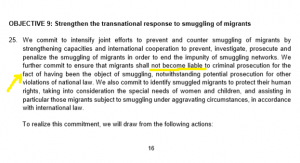

(There is a connection between smuggling and “irregular migration”)
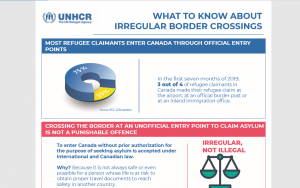
(UN High Commission on Refugees)
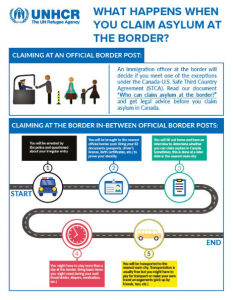
unhcr.guidelines.exceptions
UNCHR.advice.for.illegal.crossings
Objectives for Safe, Orderly and Regular Migration
(1) Collect and utilize accurate and disaggregated data as a basis for evidence-based policies
(2) Minimize the adverse drivers and structural factors that compel people to leave their country of origin
(3) Provide accurate and timely information at all stages of migration
(4) Ensure that all migrants have proof of legal identity and adequate documentation
(5) Enhance availability and flexibility of pathways for regular migration
(6) Facilitate fair and ethical recruitment and safeguard conditions that ensure decent work
(7) Address and reduce vulnerabilities in migration
(8) Save lives and establish coordinated international efforts on missing migrants
(9) Strengthen the transnational response to smuggling of migrants
(10) Prevent, combat and eradicate trafficking in persons in the context of international migration
(11) Manage borders in an integrated, secure and coordinated manner
(12) Strengthen certainty and predictability in migration procedures for appropriate screening, assessment and referral
(13) Use migration detention only as a measure of last resort and work towards alternatives
(14) Enhance consular protection, assistance and cooperation throughout the migration cycle
(15) Provide access to basic services for migrants
(16) Empower migrants and societies to realize full inclusion and social cohesion
(17) Eliminate all forms of discrimination and promote evidence-based public discourse to
shape perceptions of migration
(18) Invest in skills development and facilitate mutual recognition of skills, qualifications and
competences
(19) Create conditions for migrants and diasporas to fully contribute to sustainable development in all countries
(20) Promote faster, safer and cheaper transfer of remittances and foster financial inclusion of migrants
(21) Cooperate in facilitating safe and dignified return and readmission, as well as sustainable reintegration
(22) Establish mechanisms for the portability of social security entitlements and earned benefits
(23) Strengthen international cooperation and global partnerships for safe, orderly and regular migration
Also, consider the fact that the United Nations has studied the connection between illegal immigration and human smuggling. This is from a 2011 study released.
#4: Ensure proof of identity? That might make it easier to help get falsified documents, either from a government or a private party.
#5: Enhancing pathways for migration? Both from a legal and illegal point of view it seems open to abuse.
#9: Even though the Global Migration Compact claims to oppose human smuggling, it explicitly states (see above picture), that people who are part of smuggling won’t be prosecuted. Remember, smuggling is voluntary, unlike being trafficked.
#10: Despite wanting to monitor “irregular” routes — which are ILLEGAL entries, the UNHCR openly encourages people to enter Canada illegally, and even provides advice on how to do it. Seems pretty unhelpful to condemn human trafficking and smuggling, but then offer advice on how to circumvent local laws.
#13: Detention only as a last resort. It won’t help to deter people from bringing others in (legally or otherwise) if there are no real penalties.
#17: Sensitizing the media and promoting “proper language”. There is also a provision for pulling the funding for media deemed to be hateful. Could lodging valid criticism of human trafficking and smuggling be considered hateful?
#20: Faster, safer and cheaper remittances and “financial inclusion”? Could also double as a way to launder money out of the country, or help finance the next group of people to bring over.
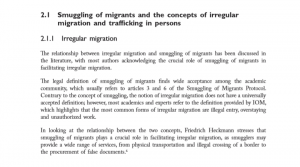
2.1 Smuggling of migrants and the concepts of irregular migration and trafficking in persons
2.1.1 Irregular migration
The relationship between irregular migration and smuggling of migrants has been discussed in the literature, with most authors acknowledging the crucial role of smuggling of migrants in facilitating irregular migration.
In looking at the relationship between the two concepts, Friedrich Heckmann stresses that smuggling of migrants plays a crucial role in facilitating irregular migration, as smugglers may provide a wide range of services, from physical transportation and illegal crossing of a border to the procurement of false documents.
Yes, this seems very obvious, but let’s hammer it home. Smuggling of people across borders is directly connected to the “irregular migration” that occurs at the end. It is the end result of these actions which show no respect for national borders or sovereignty. The UN review is rather blunt on the subject.
While the UN agreements Canada signs (the 2018 Global Migration Compact is just one) are “claiming” that respect for borders is important, the truth is that they do a lot to undermine national borders. And weak borders make for easy smuggling and trafficking.
5. Repatriation Of Terrorists To Canada
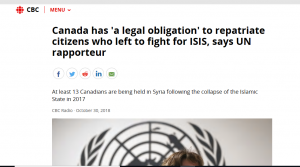
Early in Trudeau’s first mandate, Bill C-6 was introduced. It prevented dual national convicted of terrorism or treason from having their Canadian citizenship stripped and being deported. While it’s true that the UN supports terrorists being able to remain (or return) to any country they hold a passport for, this government supported doing it anyway.
Beyond terrorists themselves, the government supports a continued replacement migration from areas of the world where women and girls don’t have equality rights, and abuse it rampant.
One has to ask why though. It may be to appear compassionate in the eyes of others. It may also be to bring back or normalize an ideology that has a very different idea about what it means to be an adult. In other parts of the world, women and children have little to no rights. Remember, it’s not exploitation if it’s cloaked as multiculturalism.
6. Embracing Incompatibles As “Diversity”
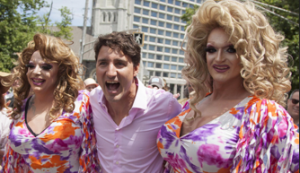
True, all politicians pander to get votes. However, our current government takes that issue much farther, and embraces the globohomo agenda. The current LGBTQ movement, lacking real issues to address, has gone down the path of sexualizing children. Even former supporters are abandoning the movement. Breaking down any sense of normality is not healthy for society, but this government supports it.
Several associates of Justin Trudeau are known pedophiles. True, one shouldn’t be judged by the company they keep, but there is a limit to that philosophy. Trudeau himself has had many bizarre claims levelled against him. (For the sake of limiting liability, let’s leave it at that.)
The government’s love of promoting (and financing) abortion at home and abroad is creepy. There’s something Satanic about the eugenics of children.
What is the real agenda behind pushing for the sexual liberation of children, or at least the ones who aren’t aborted? Is there some more heinous shoe yet to drop?
7. Lack Of Genuine Border Enforcement
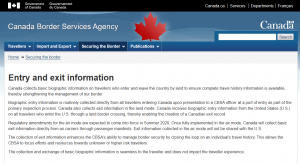
When Federal politicians are seriously discussing the ideas of expedited work permits and health care for illegals, they aren’t serious about border security. In a similar vein, when amnesty-for-illegals pilot programs are starting up, or sanctuary cities are allowed, how does that secure the border? When we don’t have a proper entry/exit system tracking people across the border, how are we more secure?
Beyond the politicians refusing to implement real border security, NGOs like: (a) Bridges not Borders; (b) Plattsburg Cares; (c) Solidarity Across Border, and others, coordinate in helping to smuggle illegal aliens across the border. The information is easy to find, yet the authorities do nothing.
There are many theories as to why the powers that be are standing down. It could be a globalist agenda. It could be open borders. It could be to import cheaper labour.
But there is another possibility. If a group of people wanted to smuggle (or traffic) young and vulnerable people across the border, what better way to do it? Would it not be much easier to move people across the border if there is no real border control?
8. Foreign NGOs Writing Our laws
Non-Governmental Organizations (NGOs), have been trying to effectively erase the Canada/U.S. border for a long time. They do it by going lobbying Parliament to rewrite our laws, and they do it by going to court and challenging our laws as “inhumane”. Here are 3 attempts that have been made in about the last 30 years.
FIRST ATTEMPT: KILL “SAFE COUNTRY” DESIGNATION
(a) Federal Court, Trial Division, Rouleau J., [1989] 3 F.C. 3
(b) Canadian Council of Churches v. Canada,
Federal Court of Appeal, [1990] 2 F.C. 534
(c) Canadian Council of Churches v. Canada (Minister of Employment and Immigration), [1992] 1 S.C.R. 236
1992.SCC.Rules.No.Standing
SECOND ATTEMPT: KILL CANADA/US S3CA
(a) 2008 ruling S3CA has no effect
Docket: IMM-7818-05
S3CA Provisions Struck Down
(b) The 2008 ruling is overturned on appeal
Canadian Council for Refugees v. Canada, 2008 FCA 229
Appeal granted, S3CA restored
THIRD ATTEMPT: TORONTO CASES TO STRIKE S3CA
(a) 2017, Prothonotary Milczynski considers consolidation
IMM-2229-17, IMM-2977-17, IMM-775-17
Milczynski Considers Consolidation
(b) 2017, CJ Crampton transfers cases to J. Diner
Crampton Transfers Consolidated Cases
(c) 2017, Justice Diner grants public interest standing
Citation: 2017 FC 1131
Amnesty Int’l, CDN Councils of Churches, Refugees
(d) 2018, Justice Diner grants consolidation of 3 cases
Citation: 2018 FC 396
Cases to be consolidated
(e) 2018, Justice Diner allows more witnesses
Citation: 2018 FC 829
2018.Diner.Calling.More.Witnesses
(f) 2019, Justice McDonald says no more witnesses
Citation: 2019 FC 418
2019.McDonald.No.More.Intervenors
The above notes are from part 16 of the series, and outline 3 attempts in Federal Court that NGOs have made to eliminate the Canada/U.S. border. This is by no means all the attempts that have been made, nor is the only border that these groups try to dissolve. Note: if a border cannot effectively stop people from entering, then it ceases to exist.
With the last attempt to strike down the Safe Third Country Agreement, the Government decided instead to just let “refugees” from the United States enter anyway through regular ports of entry.
Also worth noting is that the same NGOs who go to court for “refugee rights” and “immigrant rights” are the same ones who lobby politicians against having effective borders and tight immigration rules. The lawfare is waged both in Court, and in Parliament.
Since the Federal Government seems onboard with the open borders agenda, one has to ask why. Is it a misguided gesture of compassion to the entire world? Or is it a way to reduce barriers to letting certain people in?
9. Reduced Penalties For Child Sex Crimes
In 2016, the Liberals introduced Bill C-32, which would have lowered the age of consent for anal sex from 18 to 16. This would mean striking Section 159 from the criminal code. After public outrage, the bill was allowed to die. However, the idea was simply stuffed into Bill C-75, which also reduced the potential criminal penalties for many serious crimes.
- Section 58: Fraudulent use of citizenship
- Section 159: Age of consent for anal sex
- Section 172(1): Corrupting children
- Section 173(1): Indecent acts
- Section 180(1): Common nuisance
- Section 182: Indecent interference or indignity to body
- Section 210: Keeping common bawdy house
- Section 211: Transporting to bawdy house
- Section 242: Not getting help for childbirth
- Section 243: Concealing the death of a child
- Section 279.02(1): Material benefit – trafficking
- Section 279.03(1): Withholding/destroying docs — trafficking
- Section 279(2): Forcible confinement
- Section 280(1): Abduction of child under age 16
- Section 281: Abduction of child under age 14
- Section 291(1): Bigamy
- Section 293: Polygamy
- Section 293.1: Forced marriage
- Section 293.2: Child marriage
- Section 295: Solemnizing marriage contrary to law
- Section 435: Arson, for fraudulent purposes
- Section 467.11(1): Participating in organized crime
Bizarrely, Sections 279.02(2), and 279.03(2), which related to adults, is still an indictable offence. Guess it’s not as bad when it happens to minors.
While reducing the terrorism penalties is a messed up decision, the inclusion of these other charges largely passed unnoticed by the public. Even this website initially missed it. If it really was about pandering to Muslims (who disproportionately commit terrorism), why add these offenses in as well?
Was the focus on the terrorism offences a means to divert attention away from the watering down of child sex crimes? Is this a way to water down the penalties for people getting caught, but without making it obvious that it was the case?
10. Cutting Funding To Victims’ Shelters
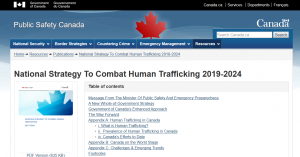
The Government of Canada brags about how much it takes the matter seriously. Yet, a recent news story reported that several groups which help victims can’t get their funding renewed.

The London Abused Women’s Centre (LAWC) said programs that help over 600 women and girls who are victims of human trafficking are being cancelled after the federal government denied funding.
LAWC, in addition to other organizations, was receiving funding through the Measures to Address Prostitution Initiatives (MAPI) fund, a five-year program that ended in March 2020.
MAPI provided funding for women and girls at risk of trafficking and those who were trafficked.
While in operation, the program helped a total of 3,107 trafficked, prostituted, sexually-exploited and at-risk women and girls in London. This included individual long-term, trauma-informed service to 650 trafficked and sexually exploited women and girls, 939 at-risk women and girls who attended groups, 173 family members from across Canada looking for their missing daughters, and 1,343 at-risk women and youth through community outreach.
However, the government recently declined to renew funding for several institutions devoted to helping trafficked victims. This was particularly bitter considering how Trudeau routinely markets himself as a feminist. Despite the recent spending spree, the Federal Government doesn’t have the money available for them.
There is another way to look at this. What organizations loudly advocate for victims though? Which groups want to see this issue pushed more in the media? What people are most likely to try to track down identities of perpetrators involved? And unlike some portions of law enforcement, who is ideologically driven to put a stop to it?
One way to help keep trafficking alive in Canada is to bankrupt institutions that are devoted to fighting this injustice. Intentional or not, that is the effect.
11. Connecting The Dots
How else would one explain the series of events as described in the above section? If not a coordinated effort to facilitate human smuggling and trafficking, then what are they? Just coincidental?
Although agreements like the UN Global Migration Compact explicitly state they oppose human smuggling, the text elsewhere says otherwise. The document objects to smuggled people to be prosecuted; it demands free social services, even for illegals; pensions and social benefits are rights; access to identity documents is a right; detention of illegals is to be minimized; and so on. The compact invites people to come to the West illegally, because of the rewards it offers. And smugglers will take advantage of it.
Our government believes that anyone with Canadian identity documents should be allowed back into Canada, regardless of what crimes they may have committed abroad. Since we’re “repatriating” Canadians, maybe they’ll bring back a child or two as well.
The globohomo agenda has gotten even more bizarre, where things like drag queen story hour are becoming normalized. Sex Ed. is being pushed on ever younger children, and younger children are being encouraged to transition. Is this a deliberate plan to desensitise the public?
Our politicians (all parties) do not take border security seriously. They allow people to come illegally, and be released into the public almost immediately. Successive governments have also failed to implement a genuine entry/exit system to track people crossing. Cities like Toronto and Hamilton are “sanctuary” cities, meaning illegals can reside there and get social benefits. Is this incompetence, or does not having border security make it harder to track smuggled and trafficked people?
Not only do our politicians and courts fail to act in the interests of Canadians, they allow NGOs (often foreign ones) to rewrite our laws. Foreign NGOs are given “public interest standing” to challenge our border laws in court. Those same groups are able to legally “lobby” Canadian public officials into supporting legislation to weaken existing laws, or just not enforce current laws. Consequently, our leaders work for outsiders, not for us.
While most people were focused on the reduced terrorism penalties in Bill C-75, many offences against children were listed as well. Why would a government not want such heinous crimes to be severely punished?
Despite repeatedly professing to support women and girls (especially when they’re in need), the Federal Government recently declined to continue funding groups to aid victims of trafficking. There’s money to spend on everything, but not on groups who would fight for these victims.
If the Government doesn’t support human trafficking, what else could explain this? Or is it all unrelated?
